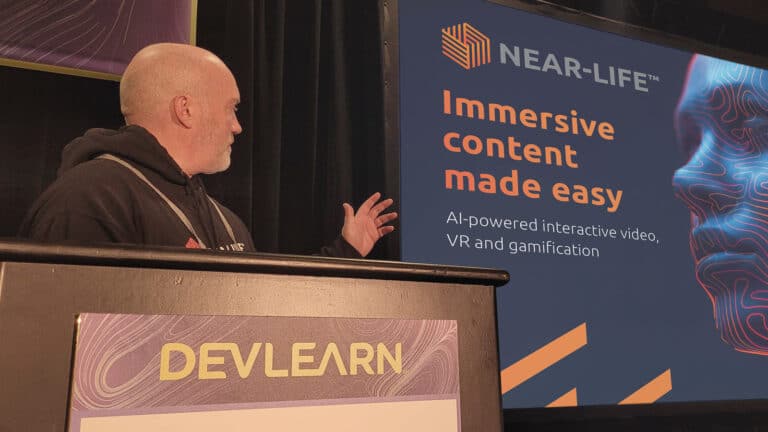Bolton edtech Near-Life has launched its latest AI-powered authoring tool at North America’s biggest learning technology event, DevLearn in Las Vegas.
This new tool sees Near-Life become the first platform to offer AI-driven functionality specifically designed to simplify the creation of immersive learning experiences using interactive video and VR, the company claims.
The new AI authoring will empower content creators by streamlining the process of designing and building interactive sequences, cutting down development time, and enhancing the richness of user experiences. It will also allow for the inclusion of AI characters within learning experiences.
“We are incredibly excited to introduce AI functionality into our platform,” said Mike Todd, Founder and CEO of Near-Life. “At Near-Life, our mission has always been to make interactive content creation as intuitive and accessible as possible. With this new AI-powered functionality, we are giving creators the power to bring their scenarios to life faster and more effectively than ever before.”
The key features of the cutting-edge tech include the ability to create AI-generated game diagrams and storyboarding. By allowing users to input descriptive prompts, Near-Life’s AI will automatically generate structured scenarios, creating a storyboard with nodes that outline the sequence of events, text, and suggested media.
Whether it’s 2D interactive video, VR, or even interactive slides and images, this feature reduces the need for detailed manual planning by providing placeholders for media files, enabling users to quickly visualise their interactive sequence. This will accelerate the development of immersive training simulations and gamified content for learning professionals.
The launch is part of an extensive AI-driven roadmap of new features and follows the recent launch of the platform’s AI-Powered image generation in London.
DevLearn attendees also got a sneak peek of the forthcoming plans around Near-Life’s work around character-based AI: enabling more dynamic interactions within scenarios. This feature will allow learners to engage with characters – such as supervisors, patients, or customers – via text-based conversations. This added layer of interaction makes for more engaging, context-rich learning experiences, particularly in professional training and simulation environments and is due for launch before the end of the year.
“With AI-generated storyboards, as well as the future addition of conversational characters, we’re adding an entirely new dimension to immersive learning. We truly believe we are pushing the boundaries of gamification and interactivity.” Todd continued. “This isn’t just about efficiency—it’s about creating deeper, more personalised experiences for learners, and we believe this will set a new standard for the industry.”














